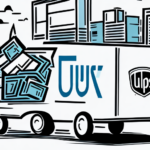Ensuring Safe and Secure Delivery: FedEx's Comprehensive Packaging and Labeling Guidelines
In our increasingly interconnected and globalized world, shipping and handling have become integral to our daily lives. Whether you're sending a heartfelt gift or dispatching packages for your business, ensuring that your shipments arrive safely and securely is paramount. FedEx, one of the most trusted shipping and logistics companies globally, offers expert advice on proper packaging and labeling to guarantee that your shipments reach their destinations in excellent condition.
The Importance of Proper Packaging and Labeling for Shipping
Proper packaging and labeling are critical components in the shipping process, ensuring that your packages are adequately protected during transit and arrive on time. Incorrect packaging can lead to damaged goods, increased costs, and a tarnished reputation. Similarly, accurate labeling ensures that your package is delivered to the correct address without unnecessary delays.
- Protection During Transit: Selecting the right packaging materials based on the product's nature, weight, and transportation mode is essential. For instance, fragile items require additional cushioning, while heavy items need sturdier boxes.
- Accurate Delivery: Proper labels with the recipient's and sender's addresses, along with any special handling instructions like "Fragile" or "This Side Up," help in the correct and timely delivery of packages.
According to the latest shipping statistics, over 70% of shipping damages are attributed to inadequate packaging. This underscores the necessity of investing time and resources into proper packaging practices.
How to Protect Your Package During Transit
Protecting your package during transit involves understanding both the item's characteristics and the transportation mode. Here are key considerations:
- Fragile Items: Use cushioning materials like bubble wrap or packing peanuts to prevent breakage.
- Liquid Items: Seal liquids tightly and place them in plastic bags to avoid leaks.
- Bulky Items: Utilize additional bracing or crating to provide extra protection.
- Climate Considerations: For items sensitive to temperature, such as electronics or perishables, use insulated packaging or opt for temperature-controlled shipping options.
Implementing these strategies can significantly reduce the risk of damage during transit, ensuring your items arrive safely and securely.
FedEx's Expert Advice on Shipping Regulations and Guidelines
FedEx offers comprehensive guidelines and resources to help you navigate shipping regulations effectively. Key aspects include:
- Weight and Size Restrictions: Understanding FedEx's specific limits helps in selecting appropriate packaging and avoiding additional fees.
- Packaging Recommendations: FedEx provides detailed advice on the best packaging materials and methods for various types of shipments.
- Labeling Requirements: Ensuring that all labels meet FedEx's standards to facilitate smooth handling and delivery.
- Shipping Options: From international shipping to overnight deliveries, FedEx offers tailored solutions to meet diverse needs.
By adhering to these guidelines, you can ensure compliance with industry standards and optimize your shipping process. For more detailed information, refer to FedEx's official shipping guidelines.
The Dos and Don'ts of Packaging and Labeling for Safe Delivery
To ensure the safe delivery of your shipments, consider the following best practices:
Dos:
- Use Sturdy Packaging: Choose boxes and materials that can withstand handling and transportation stresses.
- Label Clearly: Ensure that all addresses and handling instructions are legible and prominently placed.
- Include Accurate Content Information: Clear descriptions help prevent delays during customs or security checks.
- Monitor Shipment: Utilize tracking services to stay informed about your package's status.
Don'ts:
- Avoid Overloading: Do not exceed the recommended weight limits for your packaging, as this can lead to damage.
- Do Not Use Damaged Boxes: Recycled or weakened boxes may fail to protect your items adequately.
- Ignore Shipping Regulations: Failing to comply with shipping rules can result in fines or shipment delays.
Following these dos and don'ts will help ensure that your packages are delivered safely and efficiently.
What Happens When Your Package is Improperly Packaged or Labeled?
Improper packaging or labeling can lead to several adverse outcomes, including:
- Delays or Returns: Packages may be sent back to the sender if labeling is incorrect or incomplete.
- Damages or Losses: Inadequate packaging increases the risk of items being damaged or lost during transit.
- Fines and Penalties: Non-compliance with shipping regulations can result in financial penalties from shipping carriers or regulatory bodies.
- Safety Risks: Mislabeling hazardous materials can pose significant safety hazards to handlers.
To avoid these issues, it's crucial to adhere to FedEx's packaging and labeling guidelines meticulously. For more information, visit comparing the top shipping carriers for your business.
Common Mistakes to Avoid When Shipping Your Items
When shipping items, being aware of common mistakes can save time and resources:
- Using Incorrect Packaging Materials: Ensure materials are suitable for the item's weight, size, and fragility.
- Mislabeling Packages: Double-check addresses and handling instructions for accuracy.
- Ignoring Shipping Regulations: Stay informed about current shipping laws and guidelines to maintain compliance.
- Failing to Protect Fragile Items: Use adequate cushioning to prevent damage.
- Overloading Packages: Adhere to weight limits to avoid package compromise.
- Neglecting to Seal Packages Properly: Secure seals prevent spillage and unauthorized access.
- Not Tracking Shipments: Utilize tracking tools to monitor your package's journey and address issues promptly.
- Poor Communication with Recipients: Provide clear contact information and delivery instructions to prevent confusion.
By avoiding these mistakes, you can enhance the efficiency and reliability of your shipping process.
FedEx's Comprehensive Guide to Shipping and Handling Best Practices
FedEx provides an extensive guide on shipping and handling best practices, offering valuable insights to ensure your shipments are managed safely and efficiently. Key components of the guide include:
- Packing Techniques: Detailed instructions on how to pack various types of items effectively.
- Labeling Strategies: Best practices for creating clear and accurate labels.
- Packaging Material Selection: Guidance on choosing the right materials based on item specifications.
- Regulatory Compliance: Ensuring your shipments meet all necessary legal requirements.
Access the full guide on FedEx's website to optimize your shipping procedures: FedEx Shipping Guide.
Tips for Choosing the Right Packaging Materials for Shipping
Selecting appropriate packaging materials is vital for the protection and safe delivery of your items. Consider the following when choosing packaging materials:
- Bubble Wrap: Ideal for cushioning fragile items.
- Packing Peanuts: Useful for filling empty spaces and providing additional protection.
- Foam Inserts: Suitable for securing items within the package to prevent movement.
- Insulated Packaging: Necessary for temperature-sensitive goods.
Evaluate the weight, fragility, and size of your items to select the most appropriate materials. Proper material selection not only safeguards your shipment but also complies with FedEx's packaging standards.
How to Properly Label Your Package for Safe Delivery
Proper labeling is essential to ensure your shipment reaches the intended destination without delays or errors. Follow these guidelines for effective labeling:
- Accurate Addresses: Include both the sender's and recipient's full addresses, ensuring clarity and correctness.
- Visible Placement: Place labels on the largest side of the package in a clear, unobstructed area.
- Legible Information: Use clear fonts and avoid handwriting to ensure readability throughout the shipping process.
- Special Instructions: Clearly mark any handling instructions, such as "Fragile" or "Keep Upright," to guide handlers.
For detailed labeling requirements, refer to FedEx's labeling standards.
FedEx's Commitment to Ensuring Safe and Secure Delivery
FedEx is dedicated to providing world-class shipping and logistics services, prioritizing the safety and security of your packages. With industry-leading customer care and support, FedEx ensures that your shipments are handled with the utmost care, guaranteeing timely and secure delivery every time.
FedEx's commitment is reflected in their continuous investment in advanced tracking technologies and comprehensive training programs for their staff, ensuring that every shipment meets the highest standards of quality and reliability.
What to Do if Your Package Arrives Damaged or Lost During Transit
In the unfortunate event that your package arrives damaged or is lost during transit, take the following steps:
- Contact FedEx Immediately: Reach out to FedEx customer service as soon as you notice an issue.
- File a Claim: Provide necessary details and documentation to support your claim for damages or loss.
- Provide Additional Information: Depending on the situation, you may need to supply photos of the damage, receipts, or other relevant documents.
Prompt action is essential to resolve issues efficiently. FedEx's dedicated support team will guide you through the process to ensure a satisfactory resolution.
The Benefits of Using FedEx's Packaging Services
FedEx offers a variety of packaging services designed to meet diverse shipping needs, including:
- Custom Packaging: Tailored solutions for unique or oversized items.
- Specialty Packaging: Designed for specific industries or product types, such as electronics or perishables.
- Shipping Boxes: A wide range of box sizes and types to accommodate different shipment requirements.
- Packing Supplies: Access to high-quality materials like bubble wrap and foam inserts to enhance the protection of your items.
Utilizing FedEx's packaging services ensures that your shipments are prepared professionally, saving you time and reducing the risk of damage during transit.
How to Track Your Shipment Using FedEx's Online Tools
Monitoring your shipment's progress is straightforward with FedEx's online tracking tools. Here's how to utilize them effectively:
- Access the Tracking Portal: Visit FedEx's tracking page and enter your tracking number.
- Real-Time Updates: Receive instant updates on your shipment's status, including transit milestones and estimated delivery times.
- Alerts and Notifications: Sign up for email or SMS alerts to stay informed about any changes or delays.
- Plan for Delivery: Use the tracking information to coordinate receipt of your package, ensuring someone is available to accept it.
FedEx's robust tracking system provides peace of mind, allowing you to stay informed and manage your shipments effectively.
The Role of Proper Packing and Labeling in Preventing Damages or Loss in Transit
Proper packing and labeling are fundamental to preventing damages or losses during transit. Adhering to FedEx's guidelines ensures that your packages are handled correctly and reach their destinations without incident.
By investing in quality packaging materials, following accurate labeling practices, and complying with shipping regulations, you can significantly mitigate the risks associated with shipping. Additionally, staying vigilant through tracking and responsive communication further enhances the security and reliability of your shipments.
In conclusion, effective packaging and labeling are essential for the safe and secure delivery of your shipments. Leveraging FedEx's expert guidelines and comprehensive services can help you achieve optimal shipping outcomes, safeguarding your valuable items throughout their journey.






















